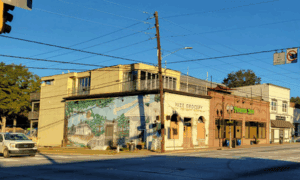The resolution to adopt the Fayetteville Tax Allocation District (TAD) redevelopment plan designed to stimulate economic development in some of the city’s older and failing commercial areas will be back on the agenda Thursday night.
The resolution was tabled Oct. 3 so meetings could be held with the Fayette County Commission and Fayette County Board of Education to further explain the plan. Both those tax-levying entities are expected to vote on their own version of the resolution later this month.
As for the city, the next phase in the implementation process for the Tax Allocation District is the adoption of the redevelopment plan by the City Council, said Fayetteville Community Development Director Brian Wismer. That vote is expected Thursday night.
“The plan includes the recommendations for the Tax Allocation District (TAD) map, which identifies areas to be targeted for redevelopment and would have the greatest potential to benefit from this financial tool,” Wismer said.
In total, the map includes 132 parcels on 215.5 acres, mainly along the Ga. Highway 85 corridor. The areas on the map represent 3.68 percent of the city’s taxable digest.
If approved by the school board and county commission and adopted by the city, the current property tax rate on those parcels will be frozen. Tax revenues will continue to be collected at the same rate each year through the 10-25-year term of the TAD.
With the TAD, it becomes a matter of a developer wishing to create a redevelopment project. If so, the incremental increase in the value of the property, the change in tax value, will flow to a fund used to create needed infrastructure or pay off an applicable project bond.
Without the TAD as an incentive for redevelopment, it becomes a question of whether a developer would choose to undertake a project in one or more of the areas that continue to deteriorate and are subject to attracting fewer business tenants and their customers.
The largest number of potential TAD project areas are located along Hwy. 85 North and include some of the city’s oldest commercial areas, many of which are sitting partially vacant and contributing decreasing dollars to the tax digest and to the county and school system.
Once the term has ended and the bond paid off, the full value of the redeveloped property goes back onto the tax rolls.
A variable cited by TAD consultants, one that often accompanies TAD projects, is the “halo effect.” Seeing the improvements being made on the TAD property, the owners of adjacent properties often improve their properties. Those improvement translate into an increased value that is assessed immediately and results in an increase in property tax revenue.
Wismer said the redevelopment plan identifies the vision and goals for the TAD, provides an assessed valuation for the properties within the TAD, methods of financing and a school system impact analysis. The hypothetical scenarios that were presented earlier are also included to create a legitimate forecast of revenue streams. It is important to note, however, that these scenarios are used for modeling purposes, and does not limit or dictate how an actual site can be developed, said Wismer.
“The redevelopment plan is an integral step in the eventual creation of the TAD. It is important to adopt the plan in a timely manner so that it can become effective in the 2014 tax year,” Wismer said. “As this will further the city’s redevelopment efforts of aging commercial areas, staff recommends adoption of the resolution and redevelopment plan as proposed.”












Leave a Comment
You must be logged in to post a comment.